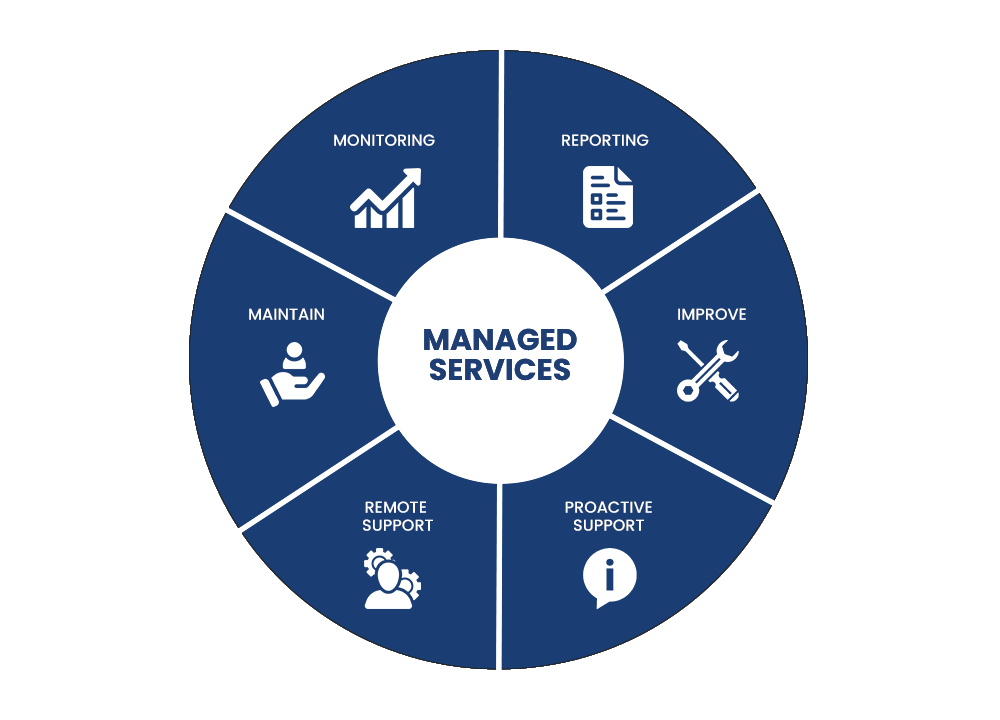Has your Salesforce-based project been closed, and the solution is already implemented? The hypercare phase has been completed, but you do not know what to do next? Do you feel that the product should be constantly developed to align with changing business processes and maintain a high level of user satisfaction? Do you want all your problems to be solved efficiently and your users to know where to report product development requirements?
If you have answered yes to the above questions, you should decide to outsource services and entrust your instances to Salesforce professionals! As part of the Managed Service, we take care of their maintenance and development. We provide ongoing technical support and propose improvements. We make sure that you always use the best available solutions.


Over the past few years, we have completed dozens of projects for global companies using Salesforce technology. As part of the Salesforce partner program, we have obtained the world’s highest Navigator Expert status for the Managed Service implementation service, confirming our vast experience and knowledge.
-
Gain the continuity of care for the system
Provide the application with continuous care thanks to the assigned Managed Service team.
-
Respond to the organization’s needs
Provide the right solutions to meet the changing demands of your business.
-
Increase customer satisfaction
React to users’ reports and eliminate system problems they notice.
-
Gain professional knowledge
Use the services of a specialized team of analysts, developers, and testers.
If Managed Service isn’t what you need, we can support your project and its business processes by establishing a customized Hours Package. At Craftware, we value flexibility and a customer-oriented approach. Therefore, we can create a service tailored to your needs. The Hours Package is the determined number of hours in a month. You can use it to support the system, add minor changes leading to system development, or consult with the technical team. Like the Managed Service, the Hours Package service is based on the SLA (service-level agreement), an agreement with a guaranteed level of service provision.
The second and third line support teams are usually involved in implementing the Hours Package. Meanwhile, a Service Delivery Manager monitors the progress and service quality. Our approach to the implementation of the Hours Package is based on years of experience and the elements of the ITIL (Information Technology Infrastructure Library) methodology. This methodology is the most common framework of best practices used globally for IT services management.


When it’s difficult to determine real customer needs concerning system maintenance and development, we offer the Proof of Concept (PoC). We use the duration of the service to get to know the system, verify the end user’s needs, and learn about the customer’s business processes. Simultaneously, we respond to the most urgent needs connected with system maintenance. In the PoC service, we often integrate the Managed Service model with the Hours Package. We often implement it for a period of three months. It’s the time that allows us to prepare the recommendation for the customer for the final system support approach.
-
A team of qualified experts
We offer the support of certified specialists with experience in the care of various systems.
-
Salesforce Partner
We have the highest partner status – a reflection of our knowledge and experience.
-
We share our knowledge
Our specialists are happy to support you with the experience and good practices recommended by Salesforce.
-
Efficiency measured by KPI and SLA
We constantly control the quality of the provided services and periodically verify the execution of the assumed objectives.
-
READ MORE
Managed Service for 5.5k users
The main objective of the Managed Service is to ensure the handling of errors and requests from users, to answer their queries, and develop a system based on Salesforce Service Cloud. The system is used, among others, by medical and sales representatives to plan and monitor daily activities, as well as to manage communication with doctors and health centers. The system is available both through a web browser and in a mobile version. About 5.500 users in Europe and EEMEA (Eastern Europe, Middle East, and Africa) are working on this solution.
-
READ MORE
Managed Service supporting users 24/5
The customer is a young company dynamically developing in the Life Sciences industry that split off from a global organization. Its portfolio includes a wide range of consumables, research services, research processes, and complete production processes.
The transfer of the company to new structures was related to the necessity of IT systems migration. Craftware was responsible for the migration of systems and adjusting Salesforce Sales Cloud to the needs of users and the new company. The next stage of work was the Salesforce Sales Cloud system maintenance and its development.
-
READ MORE
Higher quality of service thanks to a multidisciplinary team
The customer, a global pharmaceutical company, wanted to provide a higher quality of service to the system users, optimize costs and change the type of service from the standard (handling errors and user requests and system development by separate teams) to one multidisciplinary team operating in the DevOps model (Dev – development, and Ops – operations).
-
We strive to make the customer as independent as possible after implementation and have one or more administrators as an internal support line. However, companies often decide on additional support to have an experienced partner on hand in more difficult situations. We can provide such assistance under Managed Service.
-
The essence of this service is providing an external vendor with responsibility for a selected area. Which area it will be – depends on a contract between a customer and a provider; there is no typical or minimal scope of services determined in advance. Outsourcing may concern a system, chosen process, or many processes.
-
Based on our experience, we recommend a Product Owner as the main role. The Product Owner is responsible for implementation on the customer side (responsibility for business and technical requirements, coordination of other people at the customer side, responsibility for future system maintenance and development). Moreover, to complete a project, it is necessary to involve the project sponsor(s) (usually the CEO, board members), owners of the business processes that are included in the CRM, and the IT department (architect with comprehensive knowledge of the company’s systems, people responsible for individual systems that are integrated with CRM). Other important people are the Ambassadors (that is, selected system end-users) and third-party vendors. In the case of integrations with external systems, this can also include marketing agencies running campaigns for the company (Salesforce Marketing Cloud, Audience Studio, Pardot).
-
Like the Managed Service, the Hours Package service is based on the SLA (service-level agreement), an agreement with a guaranteed level of service provision. The key elements of the SLA are response, diagnosis, resolution time of incidents, and their categories. We distinguish the following incident categories:
- Critical error – a malfunction or incorrect functioning of the system involving the deterioration of the system functioning or its effectiveness, disruption in accessing the system or its module affecting all of the majority of system users. The critical error prevents users from using the system (or its significant part), making it impossible to use the Alternative Work Arrangements.
- Major error – a repetitive or permanent malfunction or incorrect functioning of the system demonstrated by the lack of system functionality or usability. It causes a breach of the requirements established for the system or makes it difficult to perform an operation. There is no possibility to apply Alternative Work Arrangements.
- Common error – a malfunction or incorrect functioning of the system that poses no threat to carrying out the system function, but it prevents users from performing individual operations or makes it necessary for the users to perform additional actions in order to carry out the system functionality. It may concern incorrect display of data.
In each type of error, we always try to find an Alternative Work Arrangement, a so-called Workaround, in other words, the method of working with the system that leads to receiving the same results of work as when using the efficient system.
For each error category, we determine the response, diagnosis, and resolution time with the customer.
- The response time is calculated from reporting an incident to confirming its receipt by Craftware and starting the initial analysis within the hours of support provided.
- The diagnosis time is calculated from reporting an incident to forwarding the error diagnosis from Craftware, underlying the reported incident, to the customer within the hours of support provided.
- The resolution time is calculated from reporting an incident to forwarding the tested solution from Craftware, resulting in repairing the system, to the customer within the hours of support provided.














